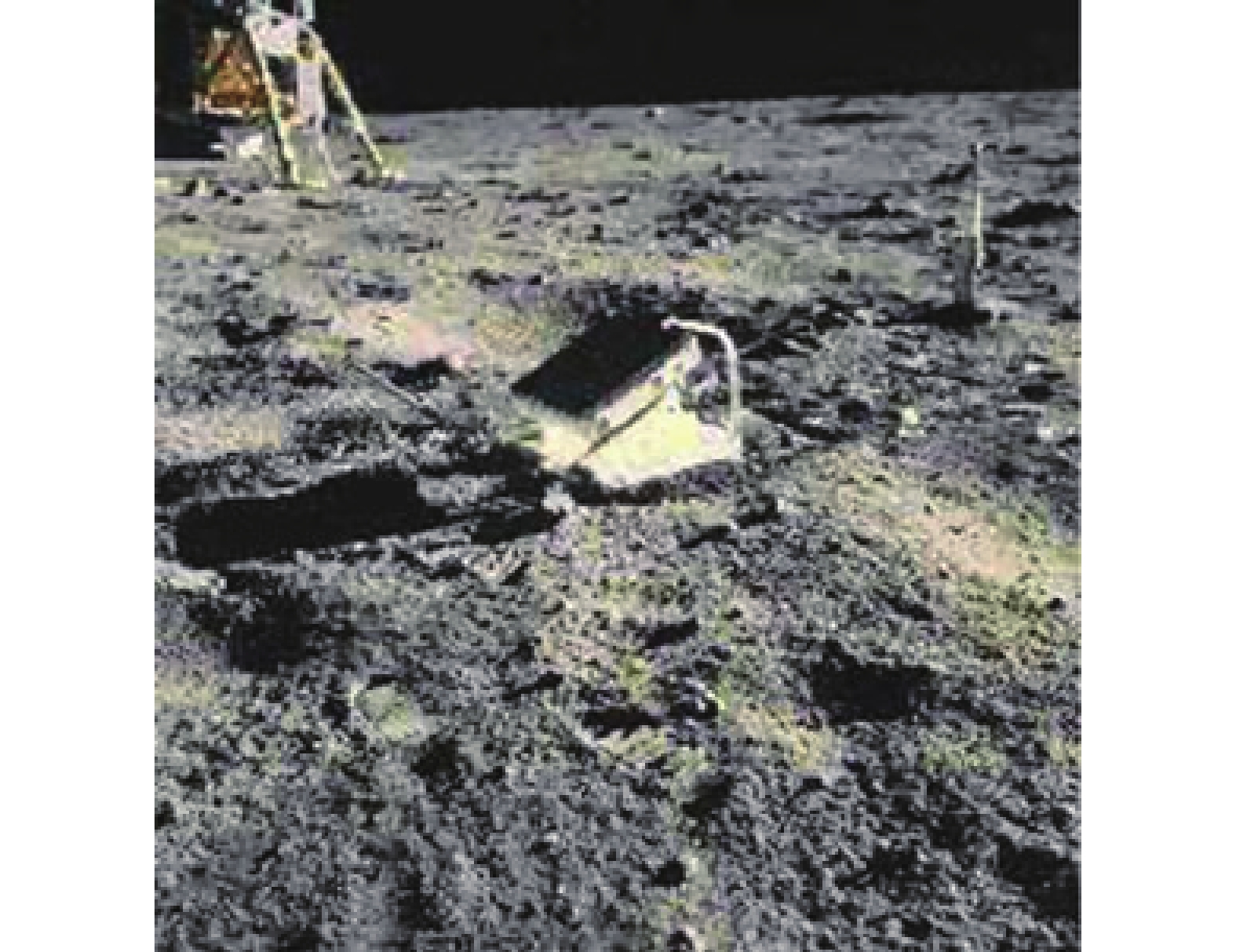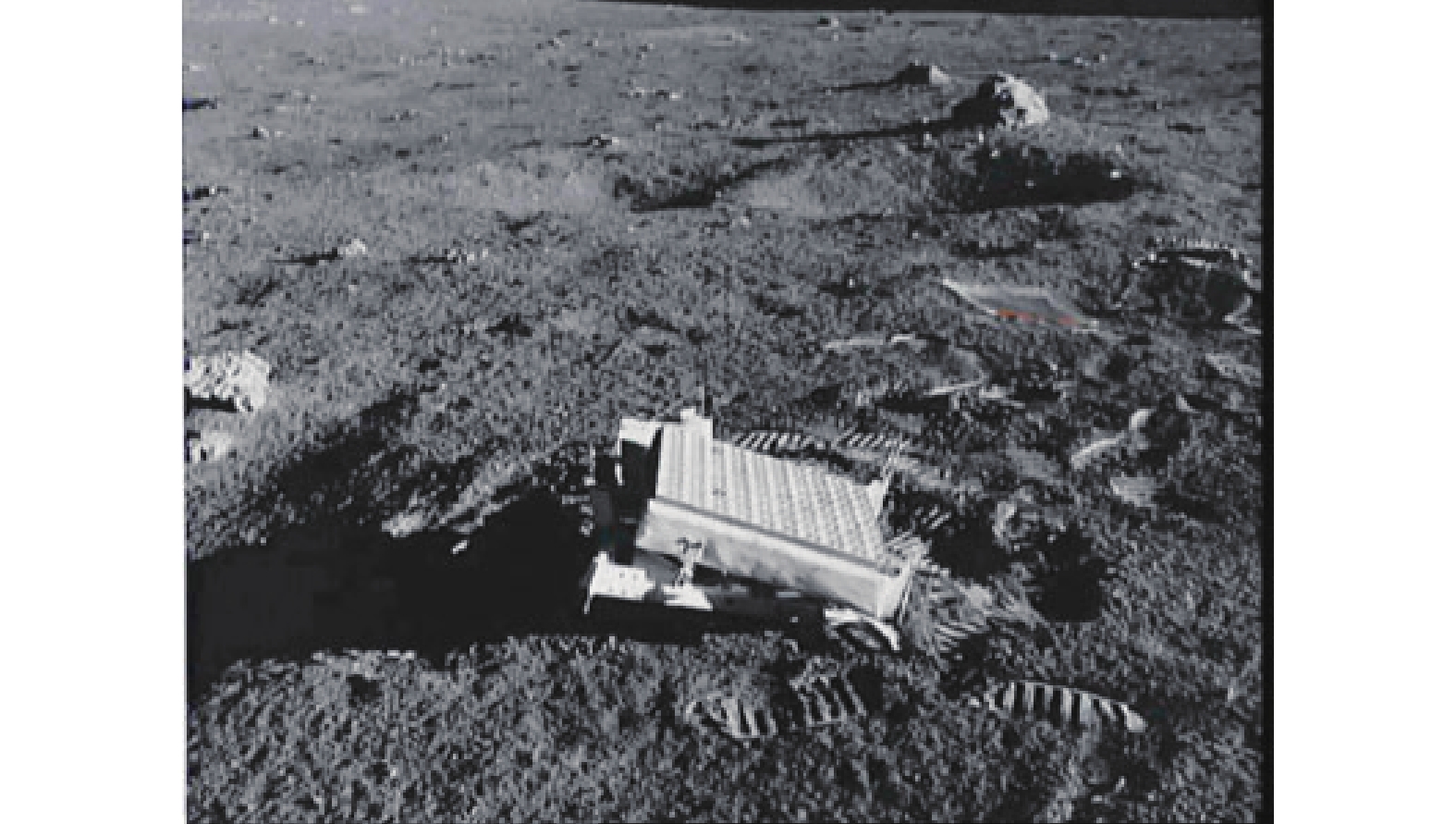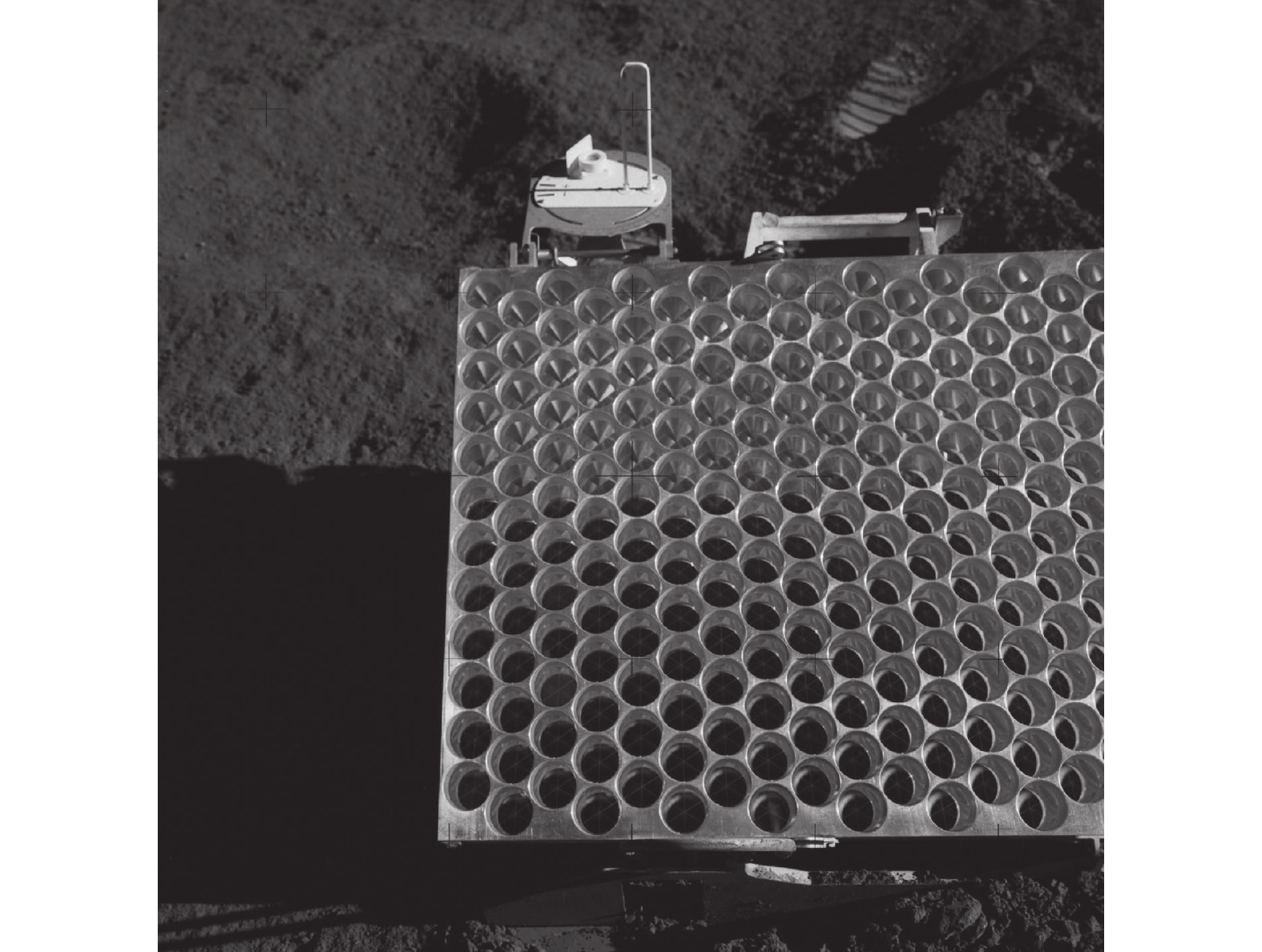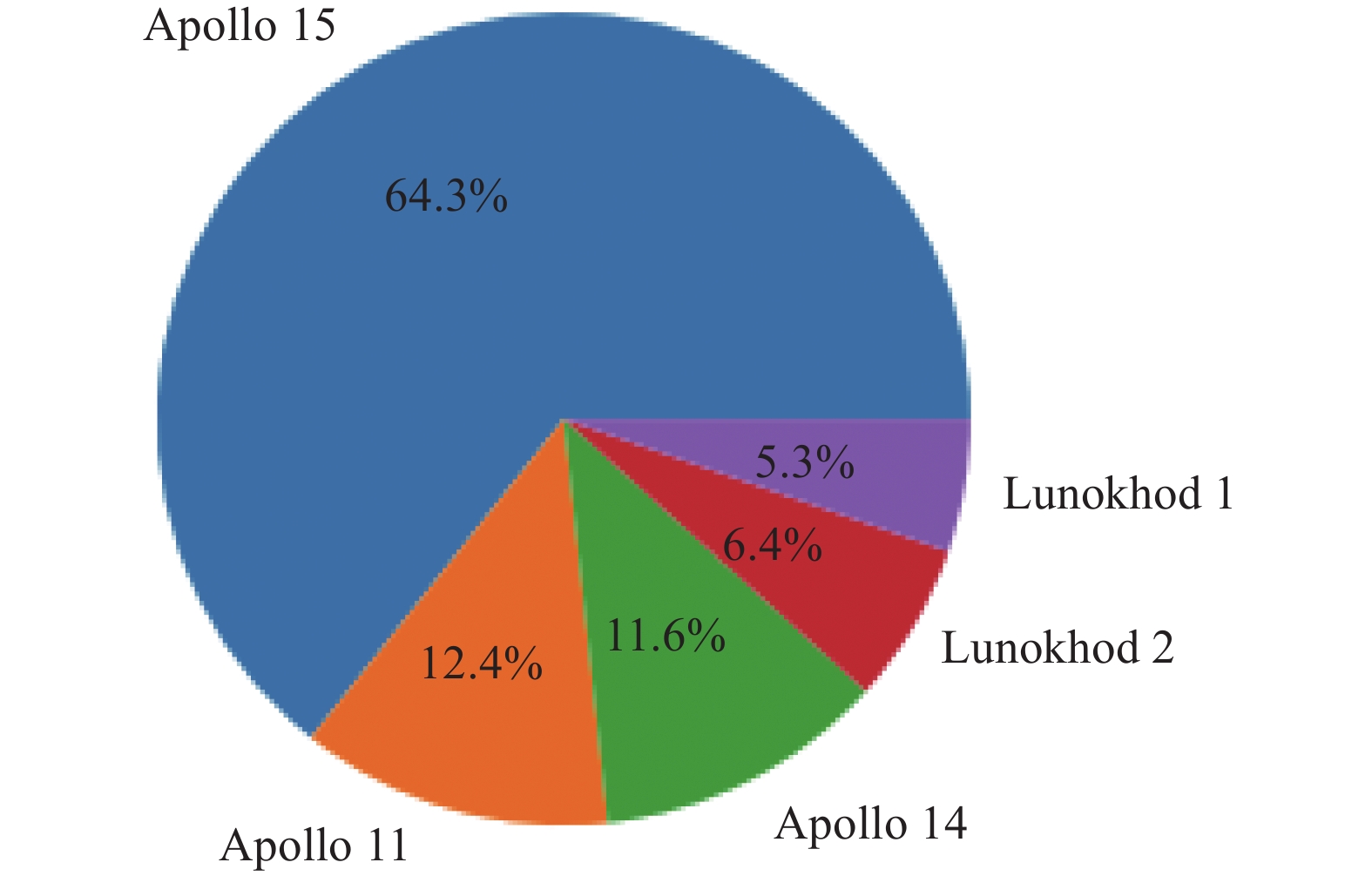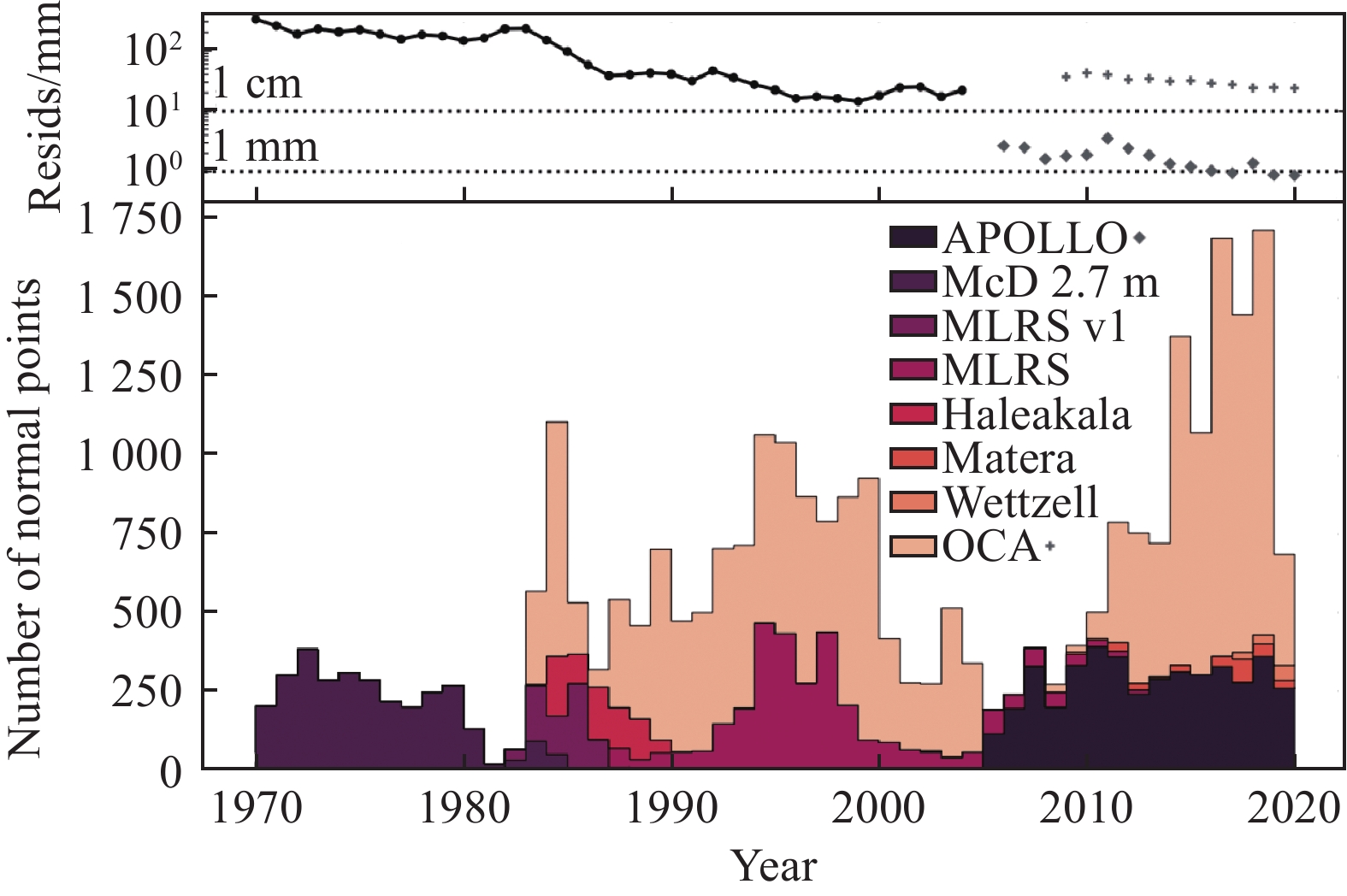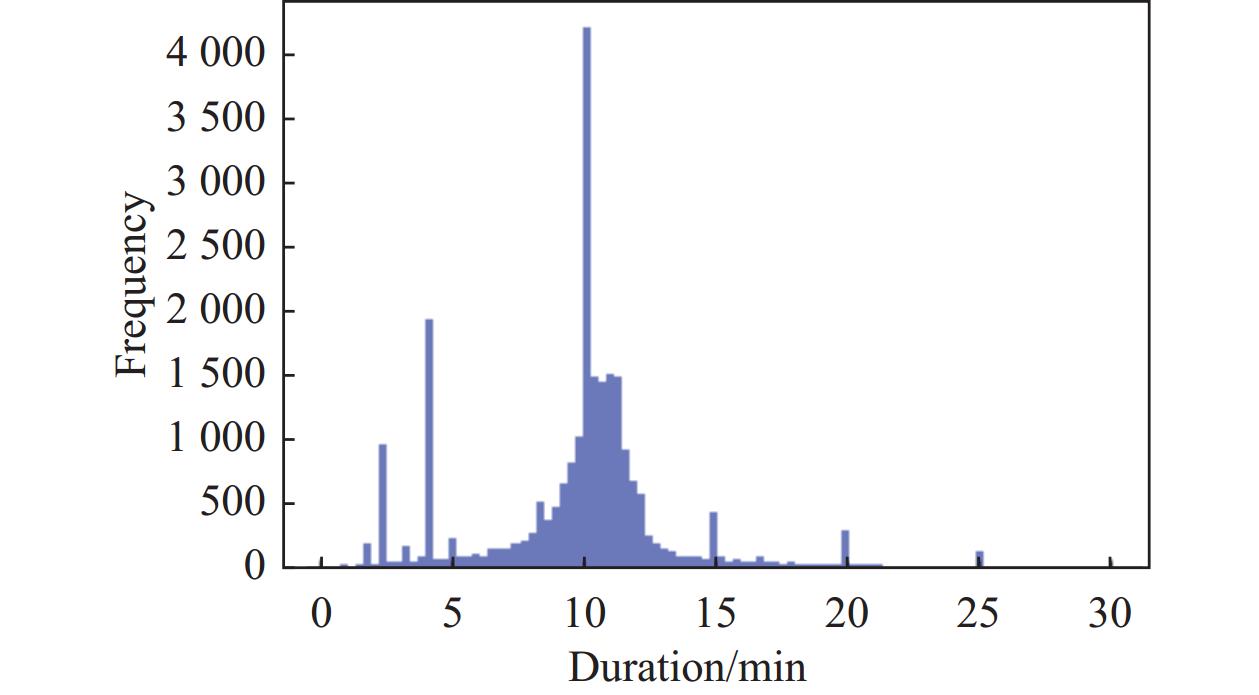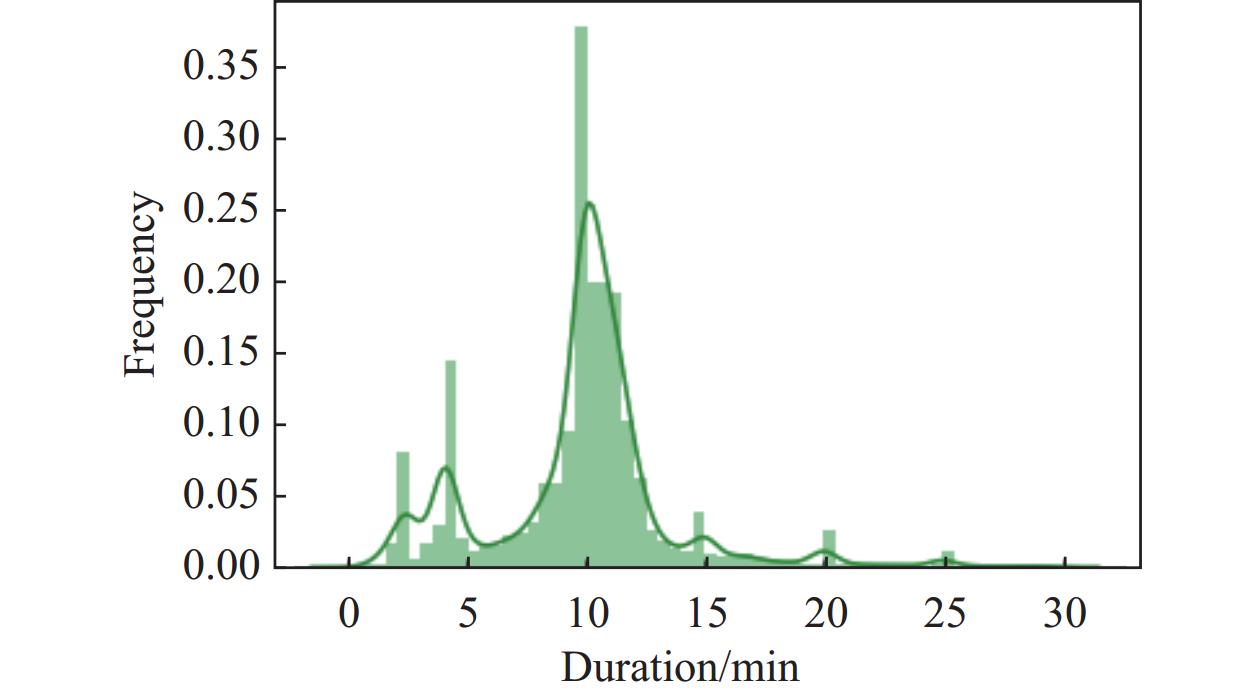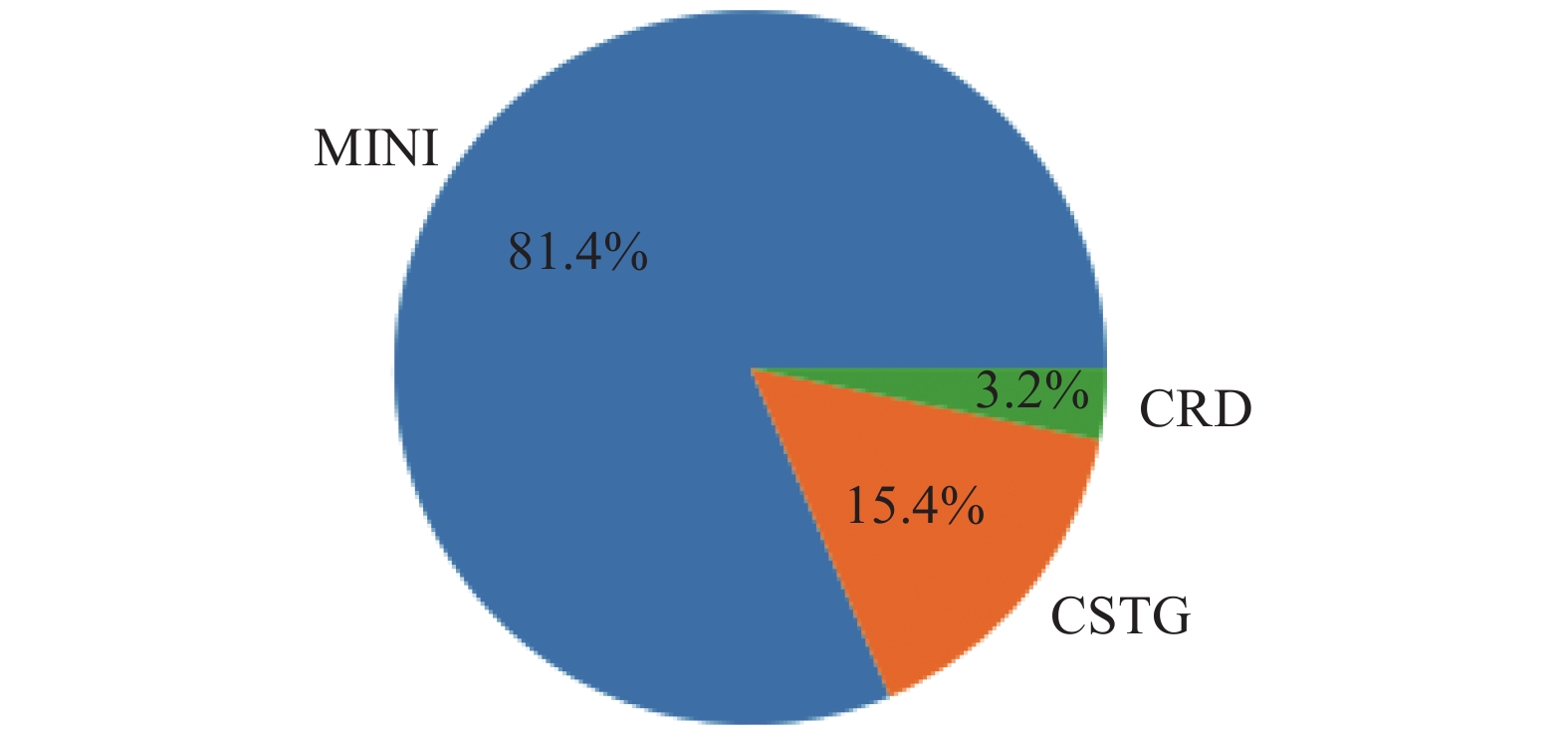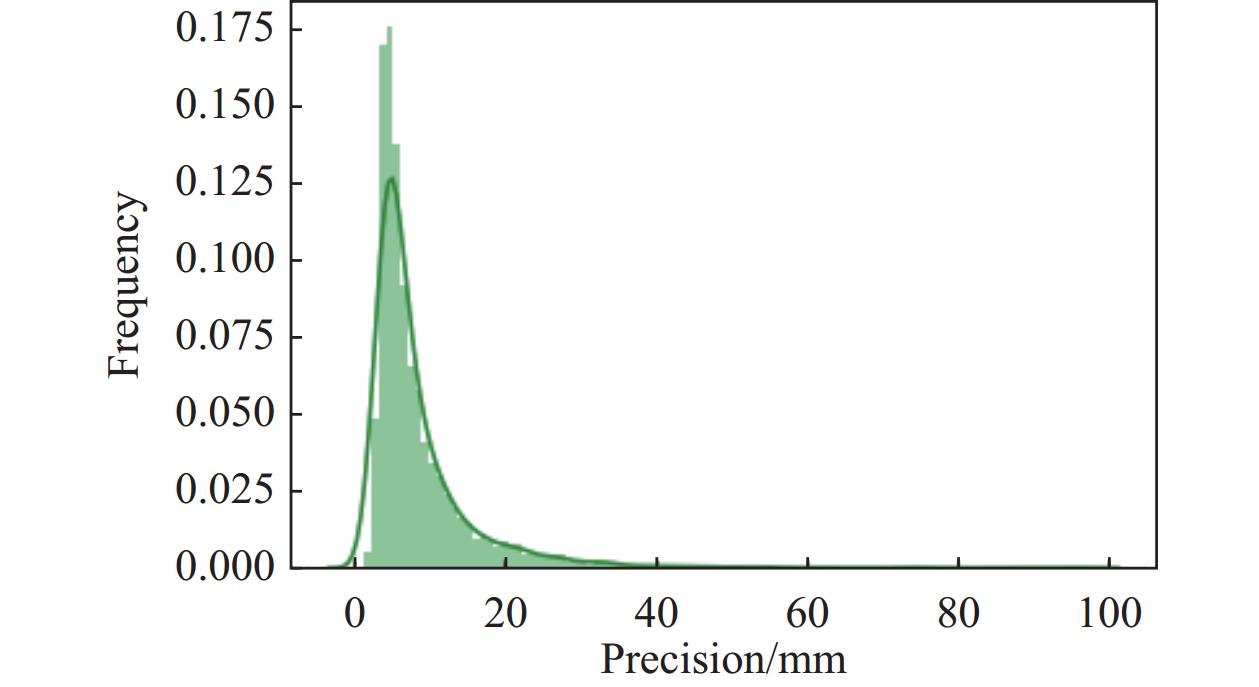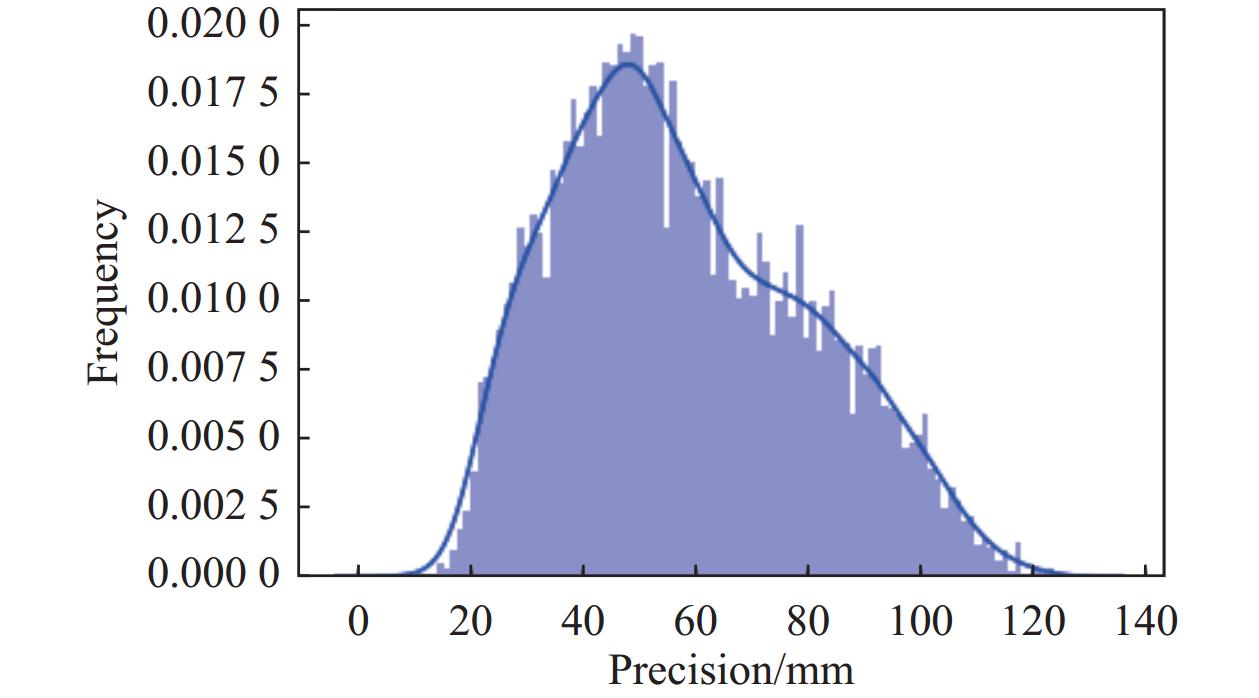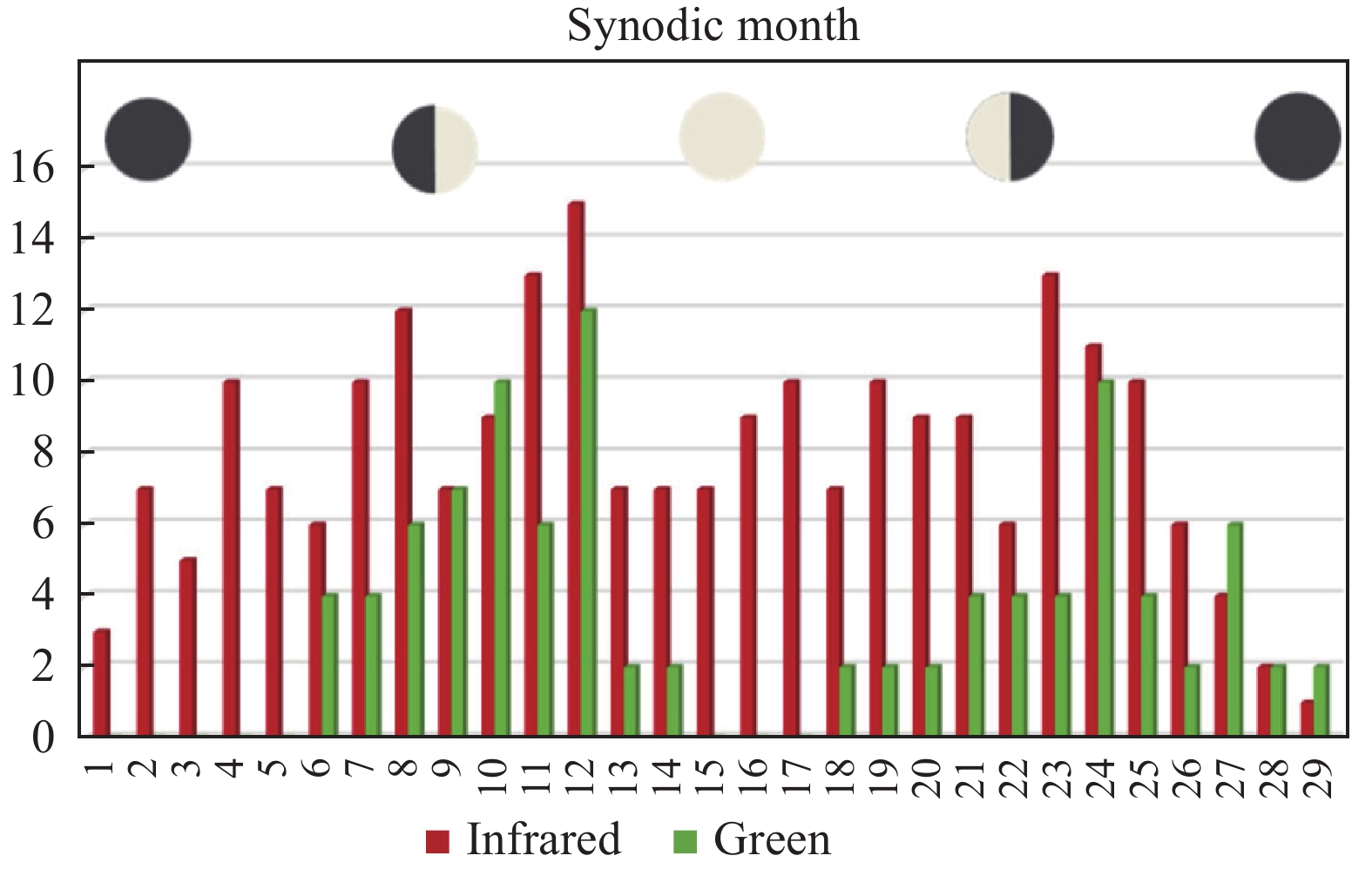-
Abstract:
This paper provides a comprehensive overview of the development of Lunar Laser Ranging (LLR), covering key components such as ground observatories, lunar retro-reflectors, and data formats. The paper details the evolution of LLR experiments conducted by some major world-class observatories, with a particular focus on addressing critical issues associated with LLR technology. Additionally, the article highlights the latest advancements in the field, elucidating scientific achievements derived from LLR data, including its contributions to gravitational theory, Earth Orientation Parameters, lunar physics exploration, and lunar librations. The review summarizes new challenges in LLR modeling and concludes with prospects for the future development of LLR.
-
Keywords:
- Lunar Laser Ranging /
- Retro-reflectors /
- Observatories /
- Gravity
-
ACKNOWLEDGMENTS: We thank Dr. Mikhail V. Vasilyev and Dr. Eleonora I. Yagudina from the Russian Institute of Applied Astronomy (IAA RAS) for providing information on the history of Lunar Laser Ranging at the Crimea Observatory and related developments of the EPM lunar ephemerides. This research is supported by the National Key Research and Development Program of China (2021YFA0715101), the National Natural Science Foundation of China (12033009, 12103087), the Strategic Priority Research Program of the Chinese Academy of Sciences (XDA0350300), the International Partnership Program of Chinese Academy of Sciences (020GJHZ2022034FN), the Yunnan Fundamental Research Projects (202201AU070225, 202301AT070328, 202401AT070141), the Young Talent Project of Yunnan Revitalization Talent Support Program. The work of the European authors is supported by ESA (European Space Agency) under the ESA-INFN contract n. 4000133721/21/NL/CR and by ASI (Agenzia Spaziale Italiana) under the Research Agreement n. 2019-15-HH.0.
-
Figure 1. Retro-reflector positions on the Moon[5].
Figure 6. Top panel: Data-Model agreement (line with points) as quantified by the RMS of the post-fit residuals of LLR data with the JPL solar system ephemeris model. Bottom panel: A stacked histogram that displays the annual count of normal point data generated by each LLR station[10].
Figure 10. Looking north along the escarpment at APO, the prominent dome silhouetted against the sky contains the LLR 3.5 m telescope. Behind and to the right of it stands the white, cone-shaped SUNSPOT solar telescope[11].
Figure 13. The ACS enclosure houses a laser, which emits a sequence of
1064 nm pulses, each lasting 10 ps, into an optical fiber. The laser repetition-rate controller, specifically the Microsemi 5071A, synchronizes the fiber laser with a cesium frequency standard. A universal counter, the Agilent 53132A, is used to compare the frequency of the cesium clock with that of a clock regulated by Global Positioning System (GPS) data, the TrueTime XL-DC. The dashed line in the diagram indicates temporary and intermittent adjustments made to observe the growing phase discrepancy between the two clocks[13].Figure 17. Repartition of normal points during the synodic month[16].
Table 1 Normal point data for major observatories
Observatory Observation time Normal point data McDonald 1969–2015 7 905 Grasse 1986–2021 18 201 Haleakala 1984–1990 770 Apache Point 2006–2021 3 877 Wettzell 2018–2021 115 Crimean Astrophysical 1973–1981 103 Matera 2003–2021 380 ALL 1969–2021 31 351 -
[1] Ye, S. H., Huang, C., 2000. Astrogeodynamics. Jinan: Shandong Science and Technology Press. (in Chinese)
[2] Porcelli, L., Currie, D. G., Muccino, M., et al. 2021. Next generation lunar laser retroreflectors for fundamental physics and lunar science. https://api.semanticscholar.org/CorpusID:265123361
[3] Dickey, J. O., Bender, P. L., Faller, J. E., et al. 1994. Lunar laser ranging: a continuing legacy of the Apollo program. Science, 265: 482−490. doi: 10.1126/science.265.5171.482
[4] Faller, J. E., Winer, I. M., Carrion, W. J., et al. 1969. Laser beam directed at the lunar retro-reflector array: Observations of the first returns. Science, 166: 99−102. doi: 10.1126/science.166.3901.102
[5] Turyshev, S. G., Williams, J. G., Folkner, W. M., et al. 2012. Corner-cube retro-reflector instrument for advanced lunar laser ranging. Experimental Astronomy, 36: 105−135. doi: 10.1007/s10686-012-9324-z
[6] Murphy Jr., T. W., Adelberger, E. G., Battat, J. B. R., et al. 2011. Laser ranging to the lost lunokhod 1 reflector. Icarus, 211(2): 1103−1108. doi: 10.1016/j.icarus.2010.11.010
[7] Murphy Jr., T. W., Adelberger, E. G., Battat, J. B. R., et al. 2007. The Apache Point Observatory lunar laser-ranging operation: Instrument description and first detections. Publications of the Astronomical Society of the Pacific, 120: 20−37. doi: 10.1086/526428
[8] Li, Y. Q., Fu, H. L., Li, R. W., et al. 2019. Research and experiment of lunar laser ranging in Yunnan Observatories. Chinese Journal of Lasers, 46(1): 180−187. (in Chinese) doi: 10.3788/CJL201946.0104004
[9] Gao, T. Q., Zhang, C. S., Li, M., et al. 2021. Research and experiment of lunar laser ranging in Sun Yat-sen University. Acta Scientiarum Naturalium Universitatis Sunyatseni, 60(Suppl1): 247−252. (in Chinese) doi: 10.13471/j.cnki.acta.snus.2020.11.11.2020b128
[10] Battat, J. B. R., Adelberger, E. G., Colmenares, N. R., et al. 2023. Fifteen years of millimeter accuracy lunar laser ranging with Apollo: Data set characterization. Publications of the Astronomical Society of the Pacific, 135: 104504. doi: 10.1088/1538-3873/aceb2f
[11] Crossley, D., Murphy, J., Liang, J. 2022. Comprehensive analysis of superconducting gravimeter data, GPS, and hydrology modeling in support of lunar laser ranging at Apache Point Observatory, New Mexico. Geophysical Journal International, 232(2): 1031−1065. doi: 10.1093/gji/ggac357
[12] Murphy, T. W. 2013. Lunar laser ranging: the millimeter challenge. Reports on Progress in Physics, 76(7): 076901. doi: 10.1088/0034-4885/76/7/076901
[13] Adelberger, E. G., Battat, J. B. R., Birkmeier, K., et al. 2017. An absolute calibration system for millimeter-accuracy Apollo measurements. Classical and Quantum Gravity, 34(24): 245008. doi: 10.1088/1361-6382/aa953b
[14] Chabe, J., Courde, C., Torre, J., et al. 2019. Recent progress in lunar laser ranging at Grasse laser ranging station. Earth and Space Science, 7(3): e2019EA000785. doi: 10.1029/2019EA000785
[15] Courde, C., Torre, J., Samain, E., et al. 2017. Lunar laser ranging in infrared at the Grasse laser station. Astronomy and Astrophysics, 602(1): A90. doi: 10.1051/0004-6361/201628590
[16] Müller, J., Murphy, T.W., Schreiber, U. et al. 2019. Lunar laser ranging: a tool for general relativity, lunar geophysics and earth science. Journal of Geodesy, 93: 2195−2210. doi: 10.1007/s00190-019-01296-0
[17] Tryapitsyn, V. N., Pavlov, D. A., Yagudina, E. I, et al. 2021. The 1970–1984 lunar laser ranging observations in the Crimean Astrophysical Observatory. Journal for the History of Astronomy, 52(1): 67−76. doi: 10.1177/0021828621989110
[18] Vasilyev, M. V., Yagudina, E. I. 2014. Russian lunar ephemeris EPM-era 2012. Solar System Research, 48(2): 158−165. doi: 10.1134/S0038094614020075
[19] Li, Y. Q., Li, Z. L., Fu, H. L., et al. 2011. Experimentation of diffuse reflection laser ranging of space debris. Chinese Journal of Lasers, 38(9): 160−164. (in Chinese) doi: 10.3788/CJL201138.0908001
[20] Zhai, D. S., Fu, H. L., Xiong, Y. H. 2010. Study of atmospheric effects on a 532nm laser and its applications in the laser ranging based on diffuse reflection. Astronomical Research & Technology, 7: 33−39. (in Chinese) doi: 10.14005/j.cnki.issn1672-7673.2010.01.010
[21] Li, Z. L., He, S. H., Fu, H. L, et al. 2012. Position control system design of return laser pulse detector for lunar laser ranging. Laser & Optoelectronics Progress, 49(5): 92−95. (in Chinese) doi: 10.3788/LOP49.051201
[22] Tang, M. R., He, L. J., Zhai, D. S., et al. 2017. Research on the distribution of echo photons in laser ranging system. Astronomical Research & Technology, 14(1): 32−38. (in Chinese) doi: 10.14005/j.cnki.issn1672-7673.20160608.006
[23] Tang, M. R., Li, Z. L., Li, Y. Q., et al. 2017. Influence of atmospheric turbulence intermittency on return photon number in laser ranging. Acta Optica Sinica, 37(2): 9−15. (in Chinese) doi: 10.3788/AOS201737.0201001
[24] Huang, K., Sun, S. B., Yang, Y. Z., et al. 2022. Research and application of lunar laser ranging observation model. Laser & Optoelectronics Progress, 59(19): 197−203. (in Chinese) doi: 10.3788/LOP202259.1912003
[25] Farrell, W. M., Stubbs, T. J., Vondrak, R. R., et al. 2007. Complex electric fields near the lunar terminator: The near-surface wake and accelerated dust. Geophysical Research Letters, 34(14): L14201. doi: 10.1029/2007GL029312
[26] Stubbs, T. J., Vondrak, R. R., Farrell, W. M. 2005. A dynamic fountain model for lunar dust. Advances in Space Research, 37(1): 59−66. doi: 10.1016/j.asr.2005.04.048
[27] Zhang, M. Y., Müller, J., Biskupek, L., et al. 2022. Characteristics of differential lunar laser ranging. Astronomy & Astrophysics, 659: A148. doi: 10.1051/0004-6361/202142841
[28] Martini, M., Dell’Agnello. 2016. Probing gravity with next generation lunar laser ranging. In Gravity: Where Do We Stand? SPIE, 195−210.
[29] Vokrouhlický, D. 1997. A note on the solar radiation perturbations of lunar motion. Icarus, 126(2): 293−300. doi: 10.1006/icar.1996.5652
[30] Williams, J. G., Turyshev, S., Boggs, D. H. 2009. Lunar laser ranging tests of the equivalence principle with the earth and moon. International Journal of Modern Physics D, 18(7): 1129−1175. doi: 10.1142/S021827180901500X
[31] Müller, J., Hofmann, F., Biskupek, L. 2012. Testing various facets of the equivalence principle using lunar laser ranging. Classical and Quantum Gravity, 29: 184006. doi: 10.1088/0264-9381/29/18/184006
[32] Hofmann, F., Müller, J. 2018. Relativistic tests with lunar laser ranging. Classical and Quantum Gravity, 35(3): 035015. doi: 10.1088/1361-6382/aa8f7a
[33] Murphy, T. W., Jr., Adelberger, E. G., et al. 2007. Variations of the gravitational constant from lunar laser ranging data. Classical and Quantum Gravity, 24: 4533−4538. doi: 10.1088/0264-9381/24/17/017
[34] Hofmann, F., Müller, J., Biskupek, L. 2010. Lunar laser ranging test of the Nordtvedt parameter and a possible variation in the gravitational constant. Astronomy and Astrophysics, 522: L5. doi: 10.1051/0004-6361/201015659
[35] Steinhardt, P. J., Wesley, D. H. 2010. Exploring extra dimensions through observational tests of dark energy and varying Newton’s constant. arXiv: 1003.2815.
[36] Williams, J. G. 1994. Contributions to the earth’s obliquity rate, precession, and nutation. The Astronomical Journal, 108(2): 711−724. doi: 10.1086/117108
[37] Turyshev, S. G., Williams, J. G. 2007. Space-based tests of gravity with laser ranging. International Journal of Modern Physics D, 16(12a): 2165−2179. doi: 10.1142/S0218271807011838
[38] Adelberger, E., G., Heckel, B. R., Nelson, A. E. 2003. Tests of the gravitational inverse-square law. Annual Review of Nuclear & Particle Science, 53: 77−121. doi: 10.1146/annurev.nucl.53.041002.110503
[39] Müller, J., Williams, J. G., Turshev, S. G., et al. 2005. Potential capabilities of lunar laser ranging for geodesy and relativity. In Dynamic Planet. Springer, Berlin, Heidelberg, 130:903−909.
[40] Nordtvedt, K. 1987. Probing gravity to the second post-Newtonian order and to one part in 10 to the 7th using the spin axis of the sun. The Astrophysical Journal, 320: 871. doi: 10.1086/165603
[41] Müller, J., Nordtvedt, K., Vokrouhlick´y, D. 1996. Improved constraint on the alpha 1 PPN parameter from lunar motion. Physical Review D, 54(10): R5927–R5930.
[42] Nordtvedt, K. 2001. Testing Newton’s third law using lunar laser ranging. Classical and Quantum Gravity, 18(20): L133−L137. doi: 10.1088/0264-9381/18/20/101
[43] Dvali, G., Gruzinov, A. V., Zaldarriaga, M. 2002. The accelerated universe and the moon. Physical Review D, 68(2): 024012. doi: 10.1103/PhysRevD.68.024012
[44] Lue, A., Starkman, G. D. 2002. Gravitational leakage into extra dimensions: Probing dark energy using local gravity. Physical Review D, 67(6): 064002. doi: 10.1103/PhysRevD.67.064002
[45] Baessler, S., Heckel, B., Adelberger, E. G., et al. 1999. Improved test of the equivalence principle for gravitational self-energy. Physical Review Letters, 83(18): 3585−3588. doi: 10.1103/PhysRevLett.83.3585
[46] Genova, A., Mazarico, E. M., Goossens, S., et al. 2018. Solar system expansion and strong equivalence principle as seen by the NASA MESSENGER mission. Nature Communications, 9: 289. doi: 10.1038/s41467-017-02558-1
[47] March, R., Bellettini, G., Tauraso, R., et al. 2011. Constraining spacetime torsion with the moon and mercury. Physical Review D, 83(10): 104008. doi: 10.1103/PhysRevD.83.104008
[48] Battista, E., Dell’Agnello, S., Esposito, G., et al. 2015. Earth-moon Lagrangian points as a testbed for general relativity and effective field theories of gravity. Physical Review D, 92(6): 064045. doi: 10.1103/PhysRevD.92.064045
[49] March, R., Bertolami, O., Muccino, M., et al. 2023. Equivalence principle violation in nonminimally coupled gravity and constraints from lunar laser ranging. Physical Review D, 109(12): 124013. doi: 10.1103/PhysRevD.109.124013
[50] Branchesi, M., Falanga, M., Harms, J., et al. 2023. Lunar gravitational-wave detection. Space Science Reviews, 219: 1−46. doi: 10.1007/s11214-023-01015-4
[51] Williams, J. G. 2007. A scheme for lunar inner core detection. Geophysical Research Letters, 34(3): L03202. doi: 10.1029/2006GL028185
[52] Williams, J. G., Boggs, D. H. 2015. Tides on the moon: Theory and determination of dissipation. Journal of Geophysical Research: Planets, 120(4): 689−724. doi: 10.1002/2014JE004755
[53] Pavlov, D., Williams, J. G., Suvorkin, V. V. 2016. Determining parameters of moon’s orbital and rotational motion from LLR observations using GRAIL and IERS-recommended models. Celestial Mechanics and Dynamical Astronomy, 126: 61−88. doi: 10.1007/s10569-016-9712-1
[54] Mariani, V., Fienga, A., Minazzoli, O., et al. 2023. Bayesian test of the mass of the graviton with planetary ephemerides. Physical Review D, 108(2): 024047. doi: 10.1103/PhysRevD.108.024047
[55] Li, J. L., Nie, S. M., Jin, W. J. 1989. Principle of the determination of the free librations of the moon by means of the LLR method. Astronomical Research & Technology, 0 (3):1−7. (in Chinese)
[56] Biskupek, L., Hofmann, F., Müller, J. 2018. Pole coordinates from the analysis of LLR data.
[57] Müller, J., Biskupek, L., Hofmann, F. 2014. Earth orientation and relativity parameters determined from LLR data. https://ilrs.gsfc.nasa.gov/lw19/docs/2014/Papers/3033_Mueller_paper.pdf.
[58] Huang, C. L., Jin, W. J., Xu, H. G., 1996. The terrestrial and lunar reference frame in LLR. Annals of Shanghai Observatory Academica Sinica, 17 : 169−175. (in Chinese)
[59] Hua, Y., Huang, C. L. 2012. Advancements in lunar laser ranging observations and research. Progress in Astronomy, 30(3): 378−393. (in Chinese)
[60] Standish, E. M., Williams, J. G. 2007. Orbital ephemerides of the sun, moon, and planets. https://vadimchazov.narod.ru/text_pdf/XSChap8.pdf.
[61] Folkner, W. M., Williams, J. G., Boggs, D. H., et al. 2014.The planetary and lunar ephemerides de430 and de431. IPN Progress Report, 42−196.
[62] Manche, H. 2011. Élaboration de l’éphéméride inpop: modèle dynamique et ajustements aux données de télémétrie laser lune.
[63] Park, R. S., Folkner, W. M., Williams, J. G., at al. 2021. The JPL planetary and lunar ephemerides de440 and de441. The Astronomical Journal, 161: 105. doi: 10.3847/1538-3881/abd414
[64] Currie, D. G., Dell’Agnello, S., Monache, G. O. D. 2008.A lunar laser ranging retroreflector array for the 21st century: Thermal and emplacement issues. In Proceedings of International Symposium on Optomechatronic Technologies.
[65] Otsubo, T., Kunimori, H., Noda, H., et al. 2010. Simulation of optical response of retroreflectors for future lunar laser ranging. Advances in Space Research, 45(6): 733−740. doi: 10.1016/j.asr.2009.12.003
[66] Ciocci, E., Martini, M., Contessa, S., et al. 2017. Performance analysis of next-generation lunar laser retroreflectors. Advances in Space Research, 60(6): 1300−1306. doi: 10.1016/j.asr.2017.06.005
[67] Williams, J. G., Porcelli, L., Dell'Agnello, S., et al. 2023. Lunar laser ranging retroreflectors: Velocity aberration and diffraction pattern. The Planetary Science Journal, 4(5): 89. doi: 10.3847/PSJ/acbeab
[68] Haviland, H. F., Weber, R. C., Neal, C. R., et al. 2021. The lunar geophysical network landing sites science rationale. The Planetary Science Journal, 3(2): 40. doi: 10.3847/PSJ/ac0f82
[69] Yang, Y. Z., Fu, H. L., Sun, S. B., et al. 2022. Corner retroreflector direction optimization for lunar laser ranging. Chinese Journal of Lasers, 49(6): 153−160. (in Chinese) doi: 10.3788/CJL202249.0604003
-
期刊类型引用(1)
1. Muccino, M., Montanari, M., Lauretani, R. et al. MoonLIGHT and MPAc: The European Space Agency’s Next-Generation Lunar Laser Retroreflector for NASA’s CLPS/PRISM1A (CP-11) Mission. Remote Sensing, 2025, 17(5): 813.  必应学术
必应学术
其他类型引用(0)




 下载:
下载:
